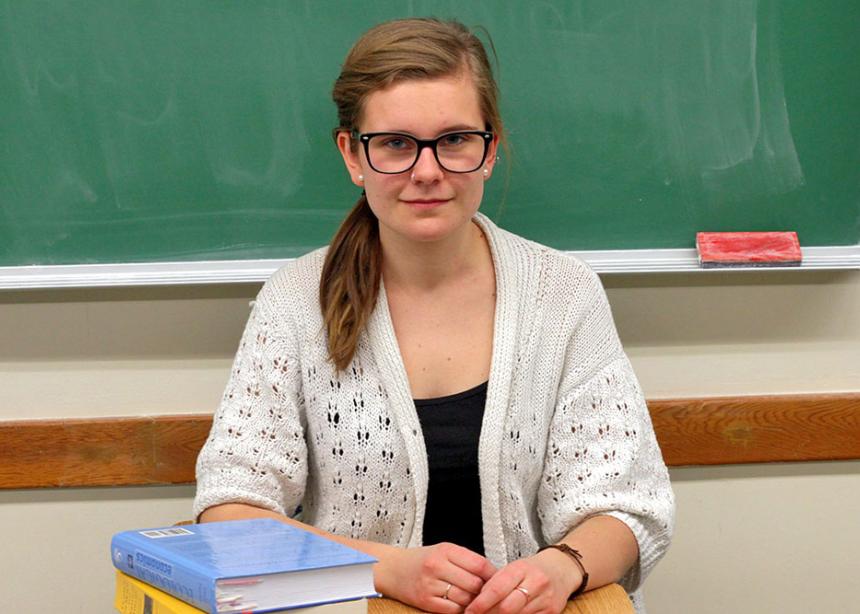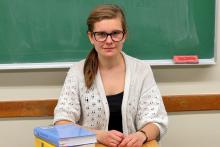Imagine these words as pictures with no direct meaning. That’s part of what it’s like to have dyslexia.
“Dyslexia is a different way of thinking,” says Mattea Nickel, 19. She was diagnosed 11 years ago, after struggling to understand written words and numbers in elementary school. Now a first-year student at Canadian Mennonite University (CMU), she’s caught between her intellectual passion and limited accommodation for her learning style.
Up to 20 percent of people show signs of dyslexia, a genetic condition in which different parts of the brain are used to understand language. Because it affects people at different levels, some never know they have it.
Nickel says, “I think in pictures,” to explain what happens in her mind. Each word she reads is not tied to its definition, but a mental picture.
This causes trouble reading and spelling, as many words and letters look similar. Words without pictures like “at” or “is” can be missed, making it tough to get the full meaning of sentences.
Dyslexia doesn’t make a person less intelligent. Learning problems linked with it come from difficulty with reading, not concepts. Cheryl Hoffmann, director of the KC Dyslexic Learning Centre in Winnipeg, says many students call dyslexia their “dirty little secret.” They understand as much as their peers but have to work harder on tests and assignments, and often get lower grades.
That doesn’t stop Nickel. She wants to be a professor, but imagines her dyslexia might make it hard to get through, or even into, higher levels of study that demand more writing.
Meeting different needs
The Canadian Dyslexia Centre says people who have dyslexia would do better in school if they could show their knowledge in different ways, like in oral or dictated exams. This gives universities a challenge: how much flexibility is possible?
Sandra Loeppky, who works in Accessibility Services at CMU, sees the unique needs of each student but struggles to provide custom support because of resources. “We’re too small to be as creative as we could be,” she says. CMU usually offers extra time and private space to students who struggle with exams.
Loeppky often wonders if writing the same test with more time just creates more anxiety. She says specialized help like readers and scribes might be better for students with dyslexia. Then they could hear the questions and speak their answers without concern for spelling. But that means finding more spaces and paying more workers.
The other challenge for universities is whether alternatives take away from the assignment’s purpose. “I’m torn,” says Loeppky, wanting to do all she can for students struggling with homework and tests. But she knows universities don’t just teach ideas, but specific skills like essay writing. For any adjustment she has to ask, “are you still meeting the course objectives?”
Nickel agrees. She tries her best to meet the university’s expectations. “If I choose to go to school and I know I don’t learn well in this style, I just have to deal with it,” she says. When asked why she accepts the challenge, she answers simply, “I love learning.”
More to be done
While Nickel is content, both she and Hoffmann know more can be done to help students with dyslexia. Hoffmann focuses on targeted instruction in reading and writing as a way to “close the gap” between reading levels and true intelligence. Since people with dyslexia read differently, trying to learn how to in the same way as everyone else can be discouraging.
Hoffmann uses the Barton reading program, a specialized method for dyslexic learners. The sooner a child can start learning this way, the better, she says.
However, Hoffman says Manitoba has too few resources. While up to 20 percent of the population may be affected, hers is the only learning centre focused on dyslexia in the province.
For Nickel, who had to travel to Saskatchewan to learn the alphabet as a child, the benefits of more local teachers are obvious. “I believe that if I was taught in a different way when I was small, I would be at a different level of intelligence today,” she says.
Hoffmann believes dyslexia will be taken more seriously as time goes on. For her part, Nickel wonders if “a new kind of intelligence will come into being,” in which students at all levels can express their learning in a style that suits them.
While she knows change will happen slowly, she looks to the future with hope.
Jonas Cornelsen, 21, majors in political studies and communications and media at CMU. He worships at Hope Mennonite Church in Winnipeg.





Comments
What an excellent article - thank you! Although I am not a young person, I always enjoy reading the Young Voices articles. They are consistently interesting, thoughtful, and well written. I wonder why they are always shoved to the back of the (print copy) Canadian Mennonite. What message does this send to our young writers?
Add new comment
Canadian Mennonite invites comments and encourages constructive discussion about our content. Actual full names (first and last) are required. Comments are moderated and may be edited. They will not appear online until approved and will be posted during business hours. Some comments may be reproduced in print.